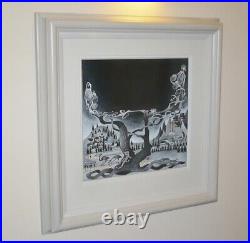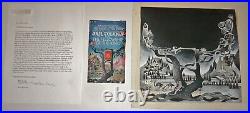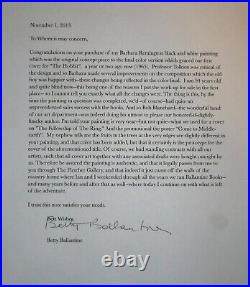J. R. R Tolkien, Original Art by Barbara Remington, Hobbit, The Lord of the Rings






We are pleased to offer for sale perhaps the most important original Tolkien related artwork. This is the original concept work presented to Ballantine publishing, the final. Of which was used on the first official paperback covers of "The Lord of the Rings" and "The Hobbit" in 1965. It includes a letter of authenticity from Betty Ballantine herself, the owner and publisher. She and her husband Ian Ballantine founded the publishing company together.
His was the concept artwork not the final artwork which was a colour version based on this piece. That it is a conceptual work gives it greater significance being the artist's first attempt at a theme. It was given to Betty as a personal gift by Barbara Remington as a thank you for commissioning a colour version.
Note, we were recently asked why the anonymous addressed letter? Betty Ballantine, who passed away on July 29th, 2020, was known as "the Queen of Paperbacks".
Barbara Remington has also just passed away. This rare art is now a true piece of history. It's difficult to remember that the hardback first editions of J. Were remaindered in the 1950s. It was only the success of the American paperbacks on American college campuses in the 1960s that sparked the boom that continues in Tolkien's work.
As aforementioned Tolkien first achieved important cult status in America on sales of millions of paperbacks and not in his own country, Great Britain. The myth prevails that Tolkien's works were best sellers from the start. That is simply not the case. In a letter to his son he expressed concern he would not have enough funds in his retirement and would have to grade papers to make ends meet.
However, Ballantine Paperbacks emerged with its now iconic artwork, the most familiar to older fans. This art is truly deserving of museum status representing as it does a key turning point in the history of Professor Tolkien's fortunes and popularity. We honestly don't know how to price the work as its significance to culture and history makes it priceless. The medium is gouache on card, glued on illustration board with the original Ballantine stock sticker on the reverse, art piece 11 x 11 inches in size plus frame and matt width.It comes with a personal certificate of authenticity letter from Betty Ballantine which is crucial to its value. It also comes with two custom made frames, one for the art and one for the letter.
The art frame has a UV protective plexi-glass panel on the reverse so that the stock sticker is visible. In 1965 Ace Paperbacks in America released unauthorized editions of the "Lord of the Rings" trilogy, the first paperback editions. This was due to a loophole in U. The rush was then on for Houghton Mifflin/Dolphin, Tolkien's U. Publisher, in collaboration with Ballantine books (Ballantine bought Dolphin paperbacks) to release authorised paperbacks of both "The Hobbit" and "The Lord of the Rings". Professor Tolkien set about this in 1965 and the changes were incorporated into the 2. Edition, 1966 hardbacks in the U. As was often the case, these revisions were delayed, forcing Ballantine Books to rush out the new editions without all the changes, using Barbara Remington artwork before the artist had actually read the books! This is why there are some strange figures in the artwork which are not in the book or anything to do with Tolkien. There was even a lion on the cover of the paperback "Hobbit" until it was airbrushed out. Professor Tolkien initially despised this artwork! See the photo above of the letter to his publisher from "The Letters of Tolkien". During an interview with N. I worked for Ballantine, and as a practice, always read the books before doing the artwork. I didn't have this luxury with the Tolkien Books, something I wish I could have changed. Ballantine was in a hurry to get these books out right away. When they commissioned me to do the artwork, I didn't have the chance to see either book, though I tried to get a copy through my friends. So I didn't know what they were about.I tried finding people that had read them, but the books were not readily available in the states, and so I had sketchy information at best. In a letter to Rayner Unwin (see photo above), 12th September 1965, Tolkien wrote.
I wrote expressing (with moderation) my dislike of the cover for the Ballantine edition of the Hobbit. I therefore will not enter into a debate about taste- (meaning though I did not say so: horrible colours and foul lettering) - but I must ask this about the vignette: what has it got to do with the story?Why a Lion and emus? And what is the thing in the foreground with the pink bulbs? He would go on in his letter to be less than complimentary as Mrs Ballantine would appear to have put her foot in it during the conversation forgetting she was speaking to the author.
Later, it would seem they made up and became friendly thanks no doubt to the huge financial success of the paperback editions. Whether he truly disliked the art or not, his main objection was accurate: it had nothing to do with the story and clearly whoever produced it hadn't read the story!
Nonetheless the colour finals became iconic with sales of the paperbacks soon to reach over a million copies and three million copies by 1969. Although Tolkien's own art appears on later editions of the Ballantine paperbacks, older fans will identify with the Remington covers as the first copies they read.Even today we find the Remington art the most recognisable of all the book covers despite Tolkien's original dislike. There have been numerous contributing artists since.
Professor Tolkien's expertise did not extend to business matters given his slow work on revisions. Had Ballantine Books not acted hastily in getting the paperbacks to the American market quickly, Tolkien's popularity and influence might be very different today. The Lord of the Rings became an America campus cult.
Middle-earth was sweeping America helped by the formation of the first Tolkien societies, long before their British counterparts, as well as helped by the hippie movement which identified with the anti-industrial themes in the book. This cult status would eventually spread throughout the world. Tolkien himself had different feelings and referred to the rising popularity as "my deplorable cultus".
When a reporter asked him about his favour with young Americans, he replied "Art moves them and they don't know what they are moved by and they get quite drunk on it". Whatever moved them, sales worldwide would exceed three million copies by the end of 1968 thanks to the release of the Ballantine paperback edition with Barbara Remington's "misinterpretation". This concept painting did in fact start it all off.
At the time, Tolkien's works were still only beginning to achieve recognition in academic circles in America, but hardly at all in his Oxford circle. Though we now view Tolkien's works as masterpieces, which the British might like to think accounts for their success, it was American cult status and availability in Ballantine paperback that made Tolkien's books, and now films, iconic.Own a real piece of history.
